Library of Congress's Blog, page 131
May 6, 2016
New Online: Walt Whitman, Heritage Months & Blogs
(The following is a guest post by William Kellum, manager in the Library’s Web Services Division.)
DIGITIZED COLLECTIONS
New online this month are two manuscript collections featuring the poet Walt Whitman. The Thomas Biggs Harned Collection of Walt Whitman papers consists of approximately 3,000 items spanning the period 1842-1937. Most of the items date from 1855, when Whitman first published the poem “Leaves of Grass,” to his death at age 73 in 1892. The online presentation includes correspondence, poetry and prose manuscripts, notes and notebooks, proofs and offprints, printed matter and miscellaneous items. The collection is accompanied by articles related to Whitman’s notebooks, describing how the poet used them to capture his thoughts and words; the repair and conservation work done at the Library; and the story of how four of the notebooks were returned to the Library 50 years after they mysteriously disappeared from the institution’s manuscript collections.

1888 printed copy of Whitman’s “O Captain! My Captain!” with Whitman’s handwritten corrections. Manuscript Division.
The Walt Whitman Papers (Miscellaneous Manuscript Collection) has some 150 items, including some of Whitman’s earliest known correspondence, and a printed copy of Whitman’s poem “O Captain! My Captain!” containing the poet’s handwritten corrections.
USER FEATURES
We’re always looking for ways to make the digital collections easier to use. This month, we’ve added new features to the digital collections portal, including the ability to use facets to filter by format, subject and the Library division that manages the content. For example, this link shows you American history-related digital collections from the Prints and Photographs Division. In the coming months, we’ll be adding additional features for working with collections.
HERITAGE MONTHS
The Asian-Pacific American Heritage Month and Jewish American Heritage Month sites provide new content, as well as a new mobile-friendly visual design, a new video player and more. The Library provides the heritage month sites in collaboration with the National Archives and Records Administration, National Endowment for the Humanities, National Gallery of Art, National Park Service, Smithsonian Institution and United States Holocaust Memorial Museum.
NEW BLOG
Finally, we add a new blog to our growing family – 4 Corners of the World Blog: International Collections and Studies. A joint project of the Library’s four area studies divisions — African and Middle Eastern, Asian, European and Hispanic – the blog will focus on the Library’s international collections, which comprise millions of items from ancient cuneiform tablets right up to materials from the present day.
May 5, 2016
Library in the News: April 2016 Edition
April headlines covered a wide range of stories about the Library of Congress.
Poet Laureate Juan Felipe Herrera continues to make the news, especially with the April announcement of his returning for a second term.
Herrera told Sara Catania of Reuters that poetry fans provided an “inspiration tsunami” during his first year in which he shepherded a crowd-sourced poem and addressed high-profile tragedies.
For his second term, he told Ron Charles of The Washington Post that he’s considering a “superhero story for children” that they would assist in writing online in addition to outreach to young people with special needs.
Speaking to his hometown newspaper the Fresno Bee Herrera said there was much more work to be done and that he was grateful and honored to be reappointed.
Mentalfloss offered 10 facts about the Poet Laureate position for Poetry Month in which they highlighted Herrera’s second term.
Also “returning” to the Library was the StoryCorps mobile recording booth, which has been on tour since 2005. The Library of Congress is the repository for the oral histories collected as part of the project, which launched in 2003. Kicking off the Library tour stop was WAMU’s Diane Rehm and her son David. Washingtonian covered the event.
The Library has certainly honored and hosted its fair share of notable individuals through the years. In April, the institution celebrated writer Mario Vargas Llosa and awarded him its Living Legend Award.
“Living, yes, I think I am living,” he told the crowd at the festivities on Monday night (as reported in the New York Times). “Not a legend.”
And, putting the spotlight on the Library of Congress itself was Ryan Cooper for The Week.
“It’s a place where you feel the weight of history pressing down,” he wrote. “‘Is this tweet really the best use of your time?’ it says. ‘Shouldn’t you be unraveling the mysteries of the universe, or writing the next great American novel?’ … “Under the dome of the Main Reading Room — as with the Capitol Rotunda — the demand to live up to the national ancestors is almost palpable.”
April 29, 2016
Pic of the Week: StoryCorps Makes a Stop
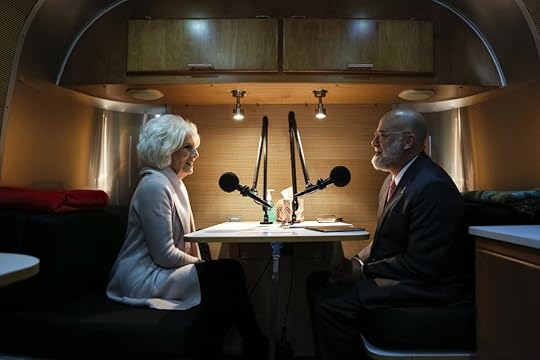
NPR host Diane Rehm and her son David conduct an interview in the StoryCorps MobileBooth. Photo by Shawn Miller.
In May 2005, two StoryCorps MobileBooths left the Library of Congress to travel across the United States—one taking an Eastern route and the other covering the Western states. This inaugural tour stopped at 34 cities, and visits lasted two and three weeks, with about 100 interviews collected at each location.
The MobileBooth returned to the Library earlier this month, 11 years after it began its journey, for a five-week stay, where it will record oral histories of residents from the Washington, D.C. area. An Airstream trailer outfitted with a recording studio, the booth is at the Library through May 18. Reservations for interviews are required and can be made by calling 1-800-850-4406 or online at storycorps.org.
The brainchild of MacArthur Fellow Dave Isay, StoryCorps was launched in 2003 as a national initiative to instruct and inspire individuals to record oral histories and create meaningful personal experiences for the participants. The Library’s American Folklife Center (AFC) serves as the permanent home for those recordings.
April 28, 2016
Welcome to the Newest Blog, 4 Corners of the World
Today we welcome the newest member of the Library’s blogosphere: 4 Corners of the World.
Dedicated to showcasing the international collections and studies at the Library of Congress, the blog will highlight important research resources and rare treasures from the Library’s four area studies divisions — African and Middle Eastern, Asian, European and Hispanic.
The term “four corners” is used in many languages to represent social and cultural diversities around the globe. The four corners are represented by the Library’s four area studies divisions. Coincidentally, today the four divisions occupy the four corners of the Library’s elegant domed Thomas Jefferson Building.
Stay tuned for more posts, and make sure to subscribe to 4 Corners of the World and other Library blogs for more great content!
Paying the Doctor in 18th-Century Philadelphia
(The following blog post is by Julie Miller, early American historian in the Manuscript Division.)
How did 18th-century Americans pay for their medical care? A leather-bound volume of patient payments kept by Philadelphia physician William Shippen Jr. between 1775 and 1793 helps answer this question. The volume is in the Shippen Family Papers in the Manuscript Division of the Library of Congress.
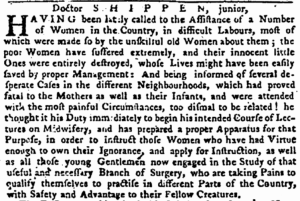
Advertisement for William Shippen Jr.’s course on midwifery, open to medical students and
women with “Virtue enough to own their Ignorance.” Pennsylvania Gazette, Jan. 31, 1765.
In Philadelphia, Shippen practiced medicine and taught anatomy, surgery and “man-midwifery” – as obstetrics was called when it was practiced by a man – for more than forty years, except for an interval during the Revolutionary War when he was director of hospitals for the Continental Army. His income came from his medical practice, teaching and also from his real estate transactions, which are also documented in the Shippen Family Papers.
Shippen’s income was bolstered by two medical innovations: inoculation for smallpox and the obstetrics training he had received in England. Smallpox inoculation was available in Philadelphia by the 1730s, but it wasn’t until the 1750s, after an outbreak, that Philadelphians began to adopt it as a regular preventive practice. The result was a rising level of immunity in the population and a significant decline in incidences of smallpox. Historian Sarah Blank Dine, who has written extensively about William Shippen, points out that Philadelphians’ adoption of smallpox inoculation was a watershed for the city’s doctors, since it gave them the opportunity to provide an income-generating service to families on a nonemergency basis. (I would like to thank Sarah Dine for kindly sharing an unpublished conference paper with me.)
Delivering babies had a similar effect on doctors’ incomes, since it too was a service frequently required by families. Male-midwifery, however, was a new idea at the beginning of Shippen’s career and it took decades to catch on. In colonial America, babies were normally delivered by female nurses and midwives without formal medical training. Doctors were typically called in to cope only when there were complications. This began to change in the 1780s as American doctors such as Shippen, who had been introduced to man-midwifery in Europe, finally won the confidence of families and began to attend routine deliveries.
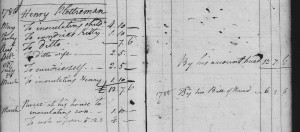
Baker Henry Plettreman paid Dr. Shippen in bread for smallpox inoculations and other medical care for his family, 1786-1788. Shippen Family Papers, Manuscript Division.
Shippen organized his records by name of household head, with approximately 330 families represented. Each entry records visits, diagnoses, procedures, prescriptions, charges and payments and in many cases stretching over decades. His family connections, his acquaintance with George Washington dating from his service to the Continental Army and the presence of the national capital in Philadelphia during and after the Revolution meant that he had many patients who could pay “cash in full.”
One of these was Pennsylvania Chief Justice Thomas McKean, to whose daughter, Molly, Shippen paid an emergency nighttime visit in 1781. In 1784 he treated a Spanish diplomat, Don Francisco Rendon (for diarrhea, among other things – maybe American food disagreed with him) and also rented him a house, earning £350 for the year – much more than the £3.10 he earned for his medical services. In 1791 he visited President Washington to treat one of his slaves, Hercules. The same year he delivered one of the 12 children of Lucy Knox, wife of Secretary of War Henry Knox. Secretary of State Thomas Jefferson was another of Shippen’s patients.
Patients without ready cash paid Shippen with goods: coffee, tea, wine, and beer; lengths of muslin, linen, and calico; handkerchiefs, silk stockings, a tablecloth, looking glasses, crockery, a tea table. Sometimes Shippen took a chance on things of dubious or uncertain value: once he accepted a lottery ticket in payment; another time he took what he described as a “bad painting.”
People who had neither goods nor cash to spare paid in labor. Bakers paid in bread, carpenters with woodcraft, tallow chandlers with candles and a barber with “dressing, &c. [etc.]” Mr. Bates, “horseman,” housed Shippen’s mare in exchange for advice on his nephritis. Some people never paid. After the name of one patient Shippen wrote “bankrupt,” after another, “gone.”
Shippen convinced a few of his wealthier patients to pay in advance with annual contracts not unlike the “concierge” plans that some doctors offer today. In January 1789, he recorded that General Stewart “agrees to pay me 15 guineas p[er]. annum for my advice & attend[an]ce &c.” Another patient, William Whiteside, agreed to the same arrangement, but had a hard time keeping up. He paid in two installments, supplementing his cash with tea and muslin. After two years he dropped the contract and resumed paying for individual services.
Because the volume is organized by family, it reveals who belonged to each household Shippen visited. Eighteenth-century households typically included not only husbands, wives and children, but also apprentices, servants and slaves. Many of these household members were legal dependents of the husband, father and master. So, for example, in 1783, Ralph Izard, a South Carolina representative to the Continental Congress, paid for medical care for his “man Frank.”
Husbands and fathers paid for wives and children but sometimes the lines of money and power in a family were unexpectedly complex. In 1783, for example, Shippen visited the family of coachman Henry Otto several times, mostly to treat his wife, who Shippen does not name. As head of household, Otto paid Shippen in washing. But women did laundry, not men. Thus it is likely that Mrs. Otto paid for her own medical care with her own labor, which her husband, as her master, owned.
Harder to work out are cases where people paid for the medical care of others outside their households. In 1789 Shippen cared for Elizabeth Hayes Darby through an illness that involved 10 visits, two “operations” and “tapping.” Darby is one of only a few women listed on her own in the records, so she was probably a widow or a spinster. In 1792 a member of the Lloyd family paid her bill of £15. The Lloyds were related to the Shippens. Could Shippen have approached a wealthy relative of his own to pay Darby’s bill? The volume doesn’t say. What it does reveal are clues about the networks of relationships that tied the city together through family, friendship and mutual obligation but also through social hierarchies that made servants, slaves and the poor dependent upon the self-interest or uncertain goodwill of the better-off.
It is worth asking just what Dr. Shippen’s patients got from him in exchange for their tea urns, tablecloths and “cash in full.” Shippen’s training in anatomy probably made him adept at repairing the dislocated wrists and broken bones he saw. But like all 18th-century doctors he purged and dosed his patients with drugs that probably did more harm than good. His smallpox inoculations protected many Philadelphians from a terrible disease. But during the epidemics of yellow fever that struck Philadelphia in the 1790s he, like every other Philadelphia physician, was helpless. When the epidemic first appeared in 1793, half of the population, including Shippen’s patients Thomas Jefferson and the Washingtons, left the city; about one-tenth of the population, many of them working people who did not have the means to flee, died. Shippen may have saved some mothers and babies from death during childbirth, but childbirth and infancy remained risky in the 18th century. Of the 12 children Lucy Knox gave birth to, nine died before they grew up.
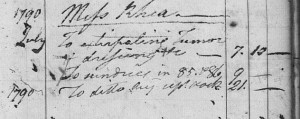
Miss Rhea, July, 1790. Shippen Family Papers, Manuscript Division.
And what about poor Miss Rhea, who he charged £7.10 for “extirpating tumor and dressing”? When she suffered this illness in 1790, Rhea still owed Shippen money from 1785 and 1786. He recorded her new charges but not that she paid. Evidently a spinster, she lived outside the protective, if controlling, canopy of a family. I wish it was possible to snatch Miss Rhea out of the 18th century and transport her to the office of a 21st-century oncologist, insurance card in hand. There she would not only have a chance to get well but to have the dignity of paying her bill, wiping out the unpaid debt that remains to this day in Shippen’s records.
Today the cost of medical care and who will pay for it are at the center of national debates. In the 18th century, as Shippen’s records show, they were worked out privately between doctor and household head. With no pool of insurance premiums to draw on, Shippen’s flexibly adapted to his patients’ abilities to pay. But the records also show that access to medical care was dependent on who could pay for you if you could not pay for yourself. In a perilous medical environment it was a chancy and deeply inequitable system that relied on social hierarchies and ties of dependency that were out of joint with the vision of equality that Shippen heard debated in Revolutionary and early national Philadelphia.
April 27, 2016
Curator’s Picks: All That Jazz
(The following is an article from the March/April 2016 issue of the Library of Congress Magazine, LCM. You can read the issue in its entirety here.)
Music Division Curator Larry Appelbaum highlights items from the Library’s exhibition “Jazz Singers.”
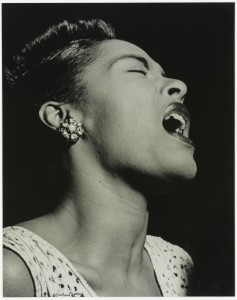 BILLIE HOLIDAY
BILLIE HOLIDAY
No matter how many times I’ve seen this iconic portrait of Ms. Holiday by William P. Gottlieb, taken in 1947, I’m always struck by the way photographer William P. Gottlieb captured her beauty and spirit in the moment of creativity. It’s a profoundly revealing image that visually evokes the sound of one of our greatest singers.
William P. Gottlieb Collection, Music Division
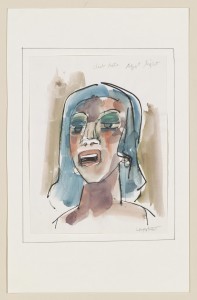 VISUAL JAZZ
VISUAL JAZZ
The Music Division’s collections include 23 watercolors by writer, cartoonist and painter Stephen Longstreet (1907–2002). This drawing titled “Club Date Spot Light” is among his compelling images depicting various aspects of jazz culture.
Music Division
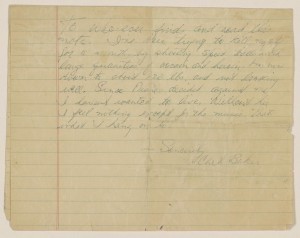
CHET BAKER LETTER
The Music Division recently acquired a cache pertaining to jazz trumpeter Chet Baker, including this chilling, undated, false-alarm suicide note detailing his descent into self-destruction. On May 13, 1988, Baker’s body was found on the sidewalk below his hotel room in Amsterdam. The exact circumstances of his death remain a mystery.
Chet Baker Collection, Music Division
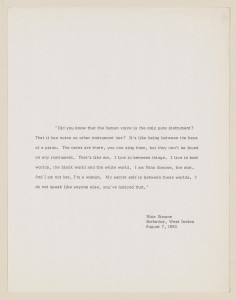 “BETWEEN THE KEYS”
“BETWEEN THE KEYS”
In the Music Division’s Max Roach Collection, I was startled to find a 1980 typescript of an unpublished autobiography by singer Nina Simone in collaboration with her friend Mary Martin Niepold, titled “Between the Keys.
Max Roach Collection, Music Division
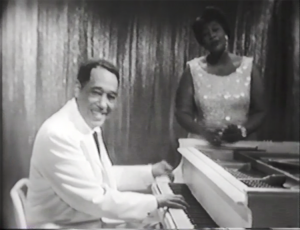 FITZGERALD AND ELLINGTON FILM CLIP
FITZGERALD AND ELLINGTON FILM CLIP
Of the many wonderful videos and film clips in the exhibition that illustrate jazz vocal artistry—including the Mills Brothers, Jimmy Rushing, Sarah Vaughan and Carmen McRae—my favorite is a rarely seen clip of Ella Fitzgerald with Duke Ellington from a 1959 Bell Telephone Hour television special. C’est magnifique!
Motion Picture, Broadcasting and Recorded Sound Division
April 25, 2016
Gathered Around the Seder Table: Images from the Passover Haggadah
(The following is a guest post by Sharon Horowitz, reference librarian in the Hebraic Section of the African and Middle Eastern Division.)
Exodus 23:15 tells us that Passover should be celebrated in the spring. The rabbis understood this to mean it was their job to maintain the holiday in the spring, which required some manipulation of the lunar-based Jewish calendar because the lunar calendar has fewer days than the solar year. Were it not for the intervention of the rabbis to establish leap years, Passover would occur during various seasons, shifting around our solar year. In order to keep Passover in the spring, Rabbi Hillel II created a perpetual calendar in the fourth century. Since that time, an extra month of 29 days is inserted into the Jewish calendar seven times in a 19-year cycle.
Passover, the Jewish holiday that celebrates the exodus of the Biblical Israelites from Egypt, has as its central ritual an event called the seder. This evening ritual usually takes place in the home, as opposed to the synagogue. As described in the Book of Exodus, groups of extended family and friends were the milieu of this ritual. In the Bible, instructions for the Paschal sacrifice and its meal required that the meat be completely consumed (no leftovers). The most practical way of accomplishing this was to band together in groups. Today, the seder continues to be a good opportunity for family reunions.
The seder rituals include reciting prayers, telling the story of the Exodus, eating certain special foods, singing songs and sharing a meal. The text for the seder is called the Haggadah. The Haggadah serves as a guide, instructional manual and script for the ritual re-enactment of the Exodus.
The oldest complete printed version of the Haggadah is found in a 10th century prayer book compiled by Rabbi Saadia Gaon, who was head of the academy in Sura, Babylonia. The earliest printed Haggadot appeared in either of two formats: as a separate entity or as part of a prayer book that contained prayers for various services of Passover and other festivals. Only in the 19th century did it become common for each person to have his or her own copy of the Haggadah at the seder. Prior to that time only the person leading the seder had a Haggadah.
Most early printed editions of the Haggadah were not illustrated. The focus was on the text and on written commentaries to the text. Over time, illustrations in the printed Haggadah set the scene and filled in various narrative lacunae for its readers. Despite the fact that on the night of Passover Jews are to narrate the Exodus, the received Haggadah text does not include extensive excerpts from the actual story in the Book of Exodus. The illustrations work together with the text to create a cohesive narrative. Illustrations also help to keep young children occupied during the evening.
Let’s look at several illustrations showing families participating in the seder rituals.
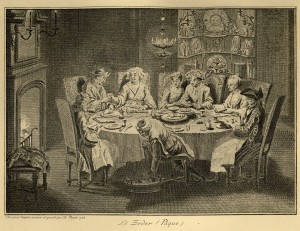
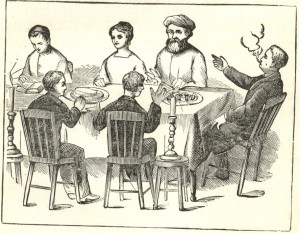
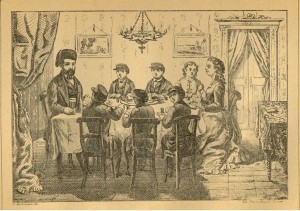
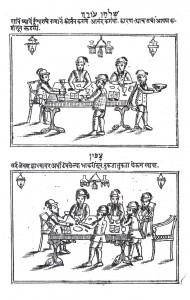
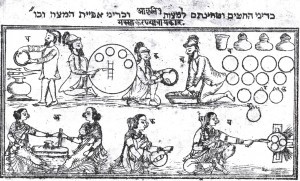
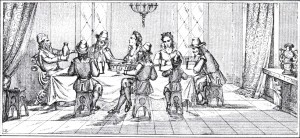
*All illustrations are from the African and Middle Eastern Division collections
The illustrations sometimes reflect local customs, such as in the Poona Haggadah. Notice that only men are sitting at the seder table. Women are included elsewhere, however, in a page showing them baking matzah.
These family scenes, with individuals in local dress and with their period interiors, are wonderful to look at. Are the luxurious surroundings of the family sitting at the table scenes real or idealized? Professor of Religion Marc Michael Epstein at Vassar College has suggested that the sumptuousness in these family images was exaggerated and not real. They were meant to bolster identity and assuage insecurities of the privileged class about their privileges and fear of losing them. He suggests we should resist seeing these family scenes as evidence of social mores and physical culture. Passover was a time to “show the face of free people” despite the types of subjugations that the 18th- and 19th-century Jews suffered.
April 22, 2016
Here’s to a Couple of Ruff Characters
Four hundred years ago this weekend, two of the greatest geniuses in wordcraft this world has ever seen both died: William Shakespeare and Miguel de Cervantes.
[image error]
The Bard
Shakespeare’s plays still dazzle, written though they are in Elizabethan English and iambic pentameter; their story lines are still fresh enough to inspire endless straight-play performance worldwide, Broadway musicals (“Kiss Me, Kate”) and international covers such as the Japanese samurai-setting movies by director Akira Kurosawa (“Throne of Blood” and “Ran.”)
[image error]
El Principe
Cervantes is known among the Spanish-speaking as “El Principe de los Ingenios,” or “The Prince of Wits,” and is recognized worldwide as the father of the modern novel for his masterpiece “Don Quixote.” Spanish national television stopped by Friday to view rare editions of that classic held by the Library, including a 1605 Madrid edition, a pirated edition of that year printed in Portugal, and a beautiful recent limited edition in Galician, with art by Galician masters. Cervantes also made it to Broadway, via “Man of La Mancha.”
[image error]
The pirated 1605 edition of “Don Quixote”
It is fitting, in the light of their towering talents, that UNESCO declared April 23 World Book and Copyright Day. How amazing is it that the thoughts of two ink-stained men can be delivered to us through books—they still speak to us four centuries after they left this earth. As Shakespeare wrote in his Sonnet 55: “Not marble, nor the gilded monuments/ Of princes shall outlive this powerful rhyme.”
The Bard and El Principe – here’s to the next 400 years.
Pic of the Week: Happy 216th Library of Congress!
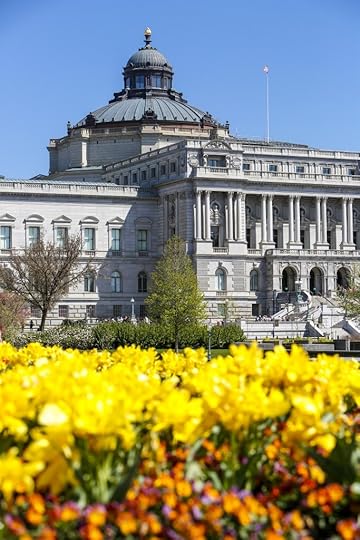
The Library of Congress Thomas Jefferson Building. Photo by Shawn Miller.
The Library of Congress celebrates its 216th birthday on Sunday. Founded on April 24, 1800, thanks to an appropriation approved by Pres. John Adams of $5,000 for the purchase of “such books as may be necessary for the use of Congress.” What started with a whopping 740 books and three maps has evolved to more than 162 million items, including more than 38 million books and other print materials, 5.5 million maps, 70 million manuscripts, 14 million photographs, 7.1 million pieces of sheet music and 3.6 million recordings.
The Library adds materials for its collections at a rate of more than 12,000 items per working day — chosen from the roughly 15,000 received daily.
Today, the Library makes freely available online more than 60.9 million primary source files, including manuscripts, newspapers, films, sound recordings and photographs. You can browse by topic the Library’s online collection items.
April 20, 2016
The Changing Field of Folklife
(The following is an article by Stephen Winick from the March/April 2016 issue of the Library of Congress Magazine, LCM. You can read the issue in its entirety here.)
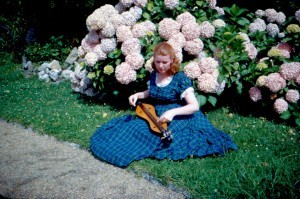
Folksinger and songwriter Jean Ritchie plays the dulcimer. George Pickow, Jean Ritchie and George Pickow Collection, American Folklife Center.
Changes in technology have facilitated global access to the Library’s folklife collections.
This year, the Library’s American Folklife Center turns 40. During that time, the world has changed in numerous ways—some small and some sweeping. Many changes have been in response to new technologies, including changes in the field of folklife.
The American Folklife Center continues to acquire collections in every conceivable format, including manuscripts, photographs, and sound and video recordings. These include collections by folklorist Alan Lomax, documentary photographers Robert Corwin and Bruce Jackson and musicians Jean Ritchie, John Cohen and David Bromberg. The center also maintains older collections, including wax-cylinder recordings dating back to 1890.
An increasing number of American Folklife Center collections—now numbering about 6 million items—have been digitized and made available online, and many collections now come to the center “born digital”—never having existed in analog (physical) form. The web itself has a culture of its own with its own vocabulary, and that, too, is being documented by the center.
IN THE BEGINNING
The American Folklife Center was established by Public Law 94-201, the American Folklife Preservation Act, which was passed by the 94th Congress and signed into law by President Gerald R. Ford on Jan. 2, 1976. The legislation placed the American Folklife Center in the Library of Congress, making it a national center for folklife documentation and research.
At the time, the nation was celebrating its bicentennial. People were thinking about the founding of the United States and what it meant to be American. Many looked to their roots in the old world and celebrated the folk customs their ancestors brought with them. Folklife programs that brought traditional culture to general audiences thrived, including museum exhibits, films and public performances. Folklorists strengthened their advocacy for folklife by offering grants, organizing apprenticeships, encouraging documentation and providing access to archival collections.
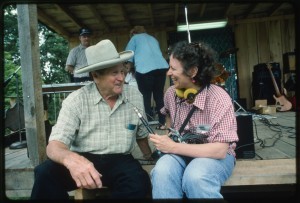
Everett Lilly is interviewed by Mary Hufford. Terry Eiler, 1996. Coal River Folklife Collection, American Folklife Center.
The center’s activities were (and remain) part of this movement. For 40 years, the American Folklife Center has had a leadership role, working closely with a network of colleagues at the Smithsonian Institution, the National Endowment for the Arts, the National Park Service and other agencies, as well as state folklore programs, to preserve, present and publish folklife resources. The center has worked behind the scenes on folklife programming, research and policy on national and international levels. Changing technologies affect all of these activities, from preserving recordings to protecting intellectual property rights. The center’s flagship publication, for example, has transitioned from a paper newsletter to a blog. Similarly, its series of free concerts, lectures and symposia, which go back to 1976, still go on today—but now the center can present them as videos online.
Congress placed the American Folklife Center at the Library of Congress, partly because the Library already had an archive of folk culture, founded in 1928. The folk culture collections had largely been built through fieldwork— recordings made by Library employees and other government organizations. These ranged from Spanish-language hymns of New Mexico and Finnish runic songs in California to the personal narratives of former slaves. They also included materials collected by folk legend Pete Seeger, and even a few Seeger performances.
The newly hired American Folklife Center staff renewed the Library’s involvement in fieldwork in the 1970s, embarking on a series of field surveys. Teams of fieldworkers interviewed people about their traditions on audio and video recordings, and also photographed and shot video of performances, rituals, and daily life. The technology on which their fieldwork was recorded and preserved had changed, but the goal of capturing American life—from cattle ranches in Nevada to the streets of Chicago and the factories of Paterson, New Jersey—had remained the same. Today, an important goal is increasing the number of these collections accessible online. The center reached a milestone with the first installment of an online presentation of the Alan Lomax Collection.
ORAL HISTORY

Folk legend
Pete Seeger sings and
plays banjo. Robert
Corwin, 1997. Robert
Corwin Collection,
American Folklife
Center.
Over 40 years, oral history has grown in the consciousness of the public and the priorities of the Library. The folk archive collected oral histories before the founding of the American Folklife Center, including interviews about the bombing of Pearl Harbor. These inspired an effort to collect similar stories after the attacks on Sept. 11, 2001
The center has also been preserving the memories of the nation’s armed forces since Congress asked the Library of Congress to launch the Veterans History Project in 2000. Since then, the center has collected 100,000 interviews of servicemen and women dating back to World War I. Many of these are available online.
Congress also charged the center to participate in the Civil Rights History Project, collecting interviews with leaders of the civil rights movement and making them available online. The center is also a major partner in the StoryCorps project, which recently launched an app so that anyone around the globe can conduct an oral history interview and share it.
DIGITAL TECHNOLOGY
Changes in technology, especially the Internet, have greatly increased public access to the Library’s collections. The center was quick to seize this opportunity, putting many of its legacy and brand-new collections online in the early days of the web. Digitizing continues to this day, with more collections going online all the time.
While digitizing physical collections is a priority, contemporary collections are increasingly born digital—arriving in the form of digital files. Such collections require entirely different procedures to preserve them and make them accessible to researchers. The center’s staff includes specialists trained to handle digital objects.
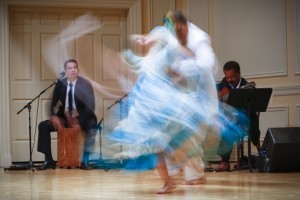
Marinera Viva presents dances of Peru in a 2015 “Homegrown” performance at the Library sponsored by the American Folklife Center. Photo by Shawn Miller.
It is also increasingly clear to folklorists that online communities are creating digital culture—much of which is, in itself, folklife. The center’s staff is engaged in critical thinking about how to capture and preserve such digital folklife.
Changes in technology have also made it easier for the public to interact with the center. Its concerts, lectures and symposia are accessible online as webcasts. Folklife events are publicized through social media and email. The public can sign up for the American Folklife Center RSS and email list, “like” its Facebook page and subscribe to the blog “Folklife Today,” all by visiting the center’s homepage.
The staff of the American Folklife Center has kept up with 40 years of change in both the field of folklife and the library world. They’re looking forward to the challenge of keeping up with the next 40 as well.
Library of Congress's Blog
- Library of Congress's profile
- 74 followers



